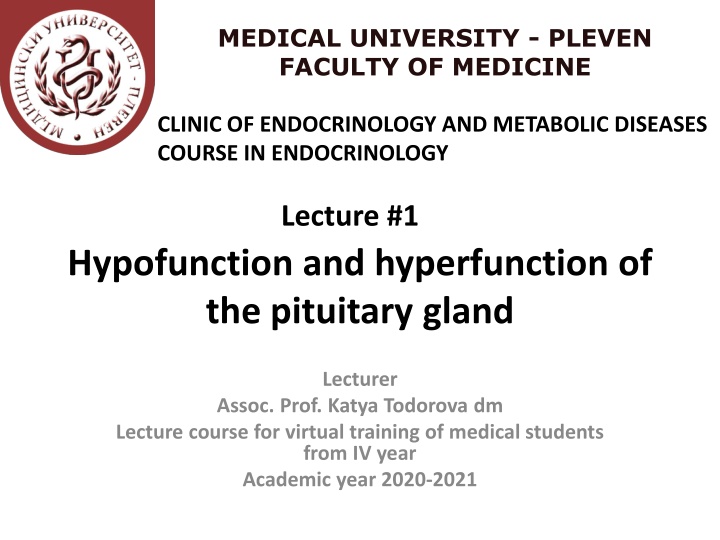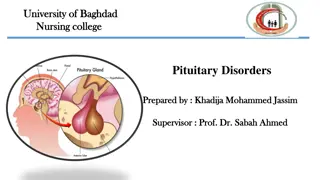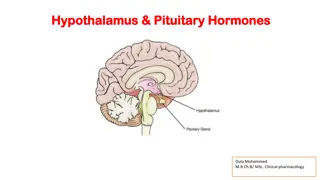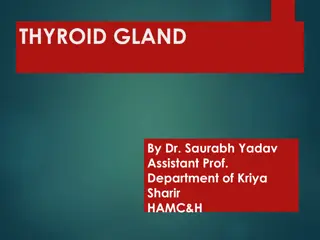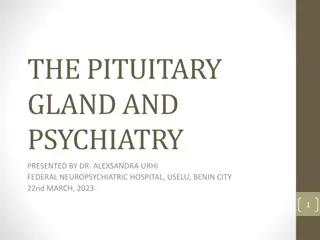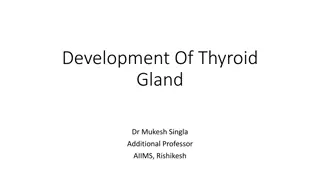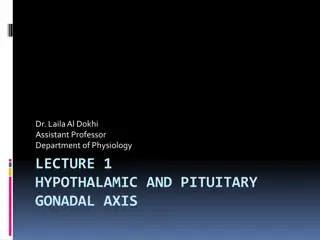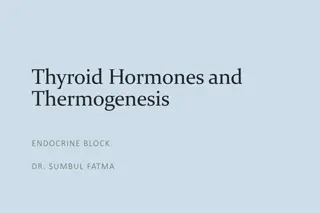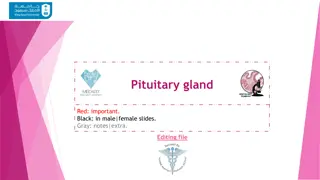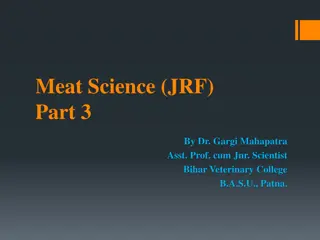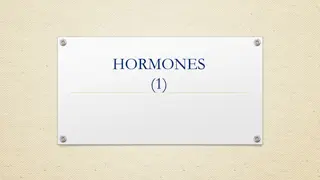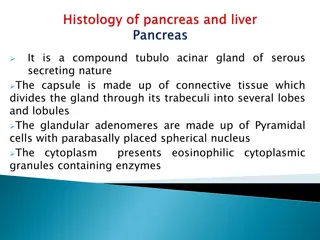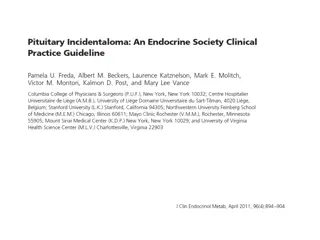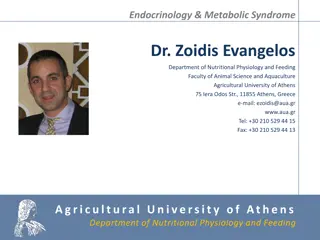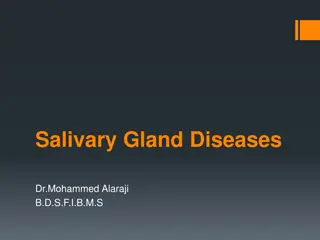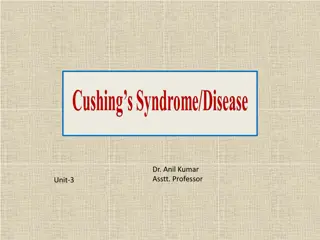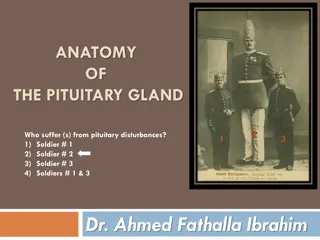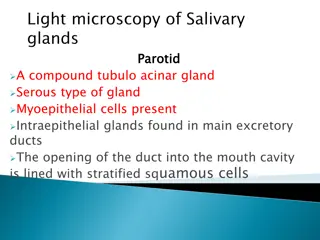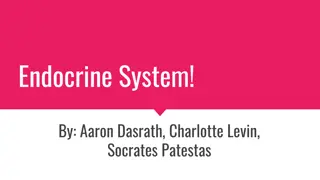Pituitary Gland Functions in Endocrinology Course
Explore the intricate workings of the pituitary gland in endocrinology, delving into hypo- and hyperfunction aspects, hormonal regulation, and physiological characteristics. Learn about the crucial role of hormones, their actions on target organs, and the specificity of their interactions with cellular receptors. Enhance your knowledge of the endocrine system through in-depth insights provided in this lecture for medical students.
Download Presentation

Please find below an Image/Link to download the presentation.
The content on the website is provided AS IS for your information and personal use only. It may not be sold, licensed, or shared on other websites without obtaining consent from the author.If you encounter any issues during the download, it is possible that the publisher has removed the file from their server.
You are allowed to download the files provided on this website for personal or commercial use, subject to the condition that they are used lawfully. All files are the property of their respective owners.
The content on the website is provided AS IS for your information and personal use only. It may not be sold, licensed, or shared on other websites without obtaining consent from the author.
E N D
Presentation Transcript
MEDICAL UNIVERSITY - PLEVEN FACULTY OF MEDICINE CLINIC OF ENDOCRINOLOGY AND METABOLIC DISEASES COURSE IN ENDOCRINOLOGY Lecture #1 Hypofunction and hyperfunction of the pituitary gland Lecturer Assoc. Prof. Katya Todorova dm Lecture course for virtual training of medical students from IV year Academic year 2020-2021
Introduction to endocrinology The endocrine system is involved in the regulation of all vital functions and the maintenance of metabolic s homeostasis. The endocrine glands, 7 in total, secrete hormones that are released in insignificant concentrations and enter the circulation directly. Endocrine regulation is effected by a change in the concentration of hormones or in the number of corresponding cellular receptors. Hormonal regulation is by including positive or negative feedback between the pituitary tropic hormone and its corresponding peripheral hormone or by increasing or decreasing the number of receptors.
A. Endocrine glands are ductless B. Hormones release directly into bloodstream https://www.slideshare.net/roger961/endocrine-system-outline-of-major-players
General physiological characteristics Hormones are biochemically derived from amino acids, peptides or steroids. They carry specific information and participate in intercellular signaling by acting as first mediators. But in addition, they induce the activity of intracellular information molecules so call second messengers. Hormones regulate: physical development and growth, biological reproduction and biochemical metabolism of the body, energy metabolism and metabolism of the salts and water. The physiological significance of the endocrine system is to maintain the body's adaptation to changing in environmental conditions.
Specificity of hormonal action Each hormone has a specific activity and affinity. It binds to the receptors on hormone-sensitive cells of the target organs. They are located of the cell membrane, in the cell cytosol and in the nucleus. The hormone-receptor complex activates the first and the second mediators, which act as intracellular messengers of information and affect the permeability of cell membranes, hormone synthesis, the activity of various cellular enzymes and others.
https://www.slideshare.net/roger961/endocrine-system-outline-of-major-playershttps://www.slideshare.net/roger961/endocrine-system-outline-of-major-players
Pituitary- hypothalamus system From Wikipedia
Hypothalamus system The hypothalamus is the control center for several endocrine and neurological functions. Damage to the hypothalamus may cause dysfunctions in: body temperature regulation, growth regulation, weight regulation, sodium and water balance, milk production, emotions, sleep cycles
Symptoms of hypothalamic disorders 1.Neurologic symptoms, 2. Endocrine changes, 3. Metabolic abnormalities such as hyperthermia and hyperphagia.
Hypothalamo-Pituitary Axis 'master' endocrineglands
Functional physiology The adenohypophysis is made up of endocrine cells that synthesize and secrete 6 hormones It is functionally linked to the hypothalamus, which secretes peptides that regulate its function by stimulating or blocking the production of hormones by the anterior pituitary gland.
Anatomy of the pituitary gland https://www.slideshare.net/roger961/endocrine-system-outline-of-major-players
Vascularisation of the pituitary gland From Wikipedia
Hormones of the adenohypophysis Most adenohypophyseal hormones have a direct effect on other endocrine glands. They are called glandotropic (or tropic) hormones. These are: Thyroid Stimulating Hormone (TSH); Adrenocorticotropic hormone (ACTH); Gonadotropic hormones - follicle-stimulating hormone (FSH) and luteinizing hormone (LH). Two more hormones are secreted from the adenohypophysis, which do not have target glands on which to act directly, but they have a common effect and are therefore called effector. These are growth hormone (GH) or (somatotropic hormone,) and prolactin (PRL).
Biological regulation of glandotropic hormones Thyroid-stimulating hormone (TSH) - by chemical structure is a glycoprotein. It stimulates the thyroid gland. The synthesis of TSH is regulated by the hypothalamus by releasing thyrotropin-stimulating hormone (TRH)and somatostatin, which blocks its production; Adrenocorticotropic hormone (ACTH) - a peptide that stimulates the secretion of adrenal glucocorticoids and partially mineralocorticoids. The hypothalamus stimulates the secretion of ACTH by secreting corticotropin-releasing hormone; Follicle-stimulating hormone (FSH) - by chemical structure is a glycoprotein. FSH stimulates the maturation of ovarian follicles and the secretion of estrogen in women, and in men it stimulates spermatogenesis. Luteinizing hormone (LH) - a glycoprotein that stimulates the development of the corpus luteum, ovulation, progesterone production in women, and in men stimulates testosterone production. FSH and LH are stimulated by hypothalamic gonadotropin-stimulating hormone.
Biologic Activity of Growth hormone GH performs its action 1). by binding to specific cytokine receptors in cartilage, bone, muscle and liver, or 2). by producing specific mediators: insulin-like growth factors 1 and 2 (IGF-1 and IGF-2). Growth hormone secretion is regulated by secretions from the hypothalamus - somatostatin and somatotropin-releasing hormone.
Biologic Activity of Prolactin Prolactin is synthesized in lactotrophic cells, which make up about 15-20% of all cells in the adenohypophysis. It acts on: the mammary glands, ovaries, and central nervous system. It stimulates the development of the mammary glands during pregnancy and stimulates milk secretion after birth. Prolactin secretion is inhibited by dopamine and somatostatin. Prolactin production is stimulated by prolactin-releasing hormone, thyrotropin-releasing hormone and oxytocin.
. Hypopituitarism Definition: Hypopituitarism is a condition of partial or complete insufficiency of hormonal secretion from the anterior pituitary gland. Frequency: In Bulgaria, between 200-300 people get sick every year. The incidence in Europe is between 300-500 per 1,000,000 population, with 20-30 people getting sick each year.
Etiology Idiopathic or congenital hypopituitarism in children (gene mutations: POUF-1 or PROP-1 causing hyposomatotropism), Traumatic or post-surgical tissue damage due to pituitary adenomectomies, Post-stroke destruction after radiotherapy of brain tumors or inoperable pituitary adenomas, Destruction from tumors and metastases, incl. apoplexy in pituitary adenoma Infiltrative injuries Autoimmune and inflammatory processes Acute hemorrhage during childbirth
Clinical significance of timely diagnosis Early detection of pituitary hormone deficiency is vital to prevent life-threatening conditions, especially an adrenal crisis. Patients with hypopituitarism have high cardiovascular morbidity and mortality, despite timely initiation of conventional hormone replacement therapy. Many of them have a poor quality of life, invariably due to the applied therapy.
Clinical picture of hypopituitarism Sequence of pituitary hormone loss: GH, FSH, LH, TSH, ACTH and PRL. ADH failure is a manifestation of severe damage or lesions involving the hypothalamus and / or infundibulum GH deficiency Fine facial wrinkles, thin skin, decreased muscle mass, increased visceral adipose tissue, insulin resistance. Osteoporosis. Reduced bone remodeling activity. Hyper- and dyslipidemia, predisposition to atherosclerosis. Increased cardiovascular mortality.
Clinical picture of hypopituitarism Deficiency of LH and FSH. Clinic of hypogonadotropic hypogonadism Men - Decreased muscle mass, decreased bone mineral density, loss of libido, erectile dysfunction, oligospermia, decreased erythropoiesis, visceral obesity and early atherosclerosis. Women - Breast atrophy, reduced pubic hair, predisposition to osteoporosis, oligo / amenorrhea and infertility.
Clinical picture of hypopituitarism TSH deficiency - a clinic of hypothyroidism . Intolerance to cold, fatigue, muscle pain, adipose tissue deposition in the hips and thighs, myxedematous swelling of the soft tissues in the face and around the eyes, rough, pale, dry and flaky skin, delayed reflexes, decreased memory, concentration, depression, constipation, heart failure, etc. Hyponatremia, normochromic, normocytic anemia, pericardial effusion.
Clinical picture of hypopituitarism ACTH deficiency. The clinic is determined by the deficiency of cortisol and adrenal androgens Fatigue, weakness, headache, anorexia, weight loss, nausea, vomiting, abdominal pain, myalgia, decreased concentration. Hypoglycemia, hyponatremia, decreased renal clearance of free water. Reduced hair in women. Important! In contrast to primary hypocorticism, these patients did not have melanodermia and no hyperkalaemia .
Basic research of pituitary hormones Adrenocortical axis : ACTH and serum cortisol (at 6.00 and 22.00). Thyroid axis : TSH, free fractions of T4 and T3, Gonadal axis : men - LH, FSH and testosterone (9.00 am); women - LH, FSH, estradiol 1-5 days in menstruation) and progesterone (21 days in menstruation) Prolactin
Dynamic hormonal diagnostics Diagnosis of hyposomatotropism: Measurment of GH, and conducting a stimulation test with insulin hypoglycemia (gold standard). Diagnosis of hypogonadism: Examination of LH, FSH, T, E2 and LH-RH test, Diagnosis of hypothyroidism: Measurment of TSH and FT4, Diagnosis of hypocorticism: Measurment of ACTH and cortisol. Cortisol levels below 100 nmol / L. are evidence of hypocorticism, between 100 and 500 nmol / l. require a Synacthenic test.
Interpretation of hormonal tests Adrenal axis : Low ACTH and low serum cortisol levels at 6.00 and 22.00. Thyroid axis : Low TSH and low / normal FT4. Sometimes low peripheral hormones are accompanied by normal levels of TSH, which indicates the secretion of biologically inactive TSH. Gonadal axis : men - Low levels of LH, FSH and testosterone; women - Low levels of LH, FSH, estradiol and progesterone. Low GH: IGF-1 lower than the lower limit Insulin test (0.1U / Kg) STH <5.1 ng / ml Glucagon stimulation test (1mg) STH <3 ng / ml Low prolactin Measure of plasma and urinary osmolality and clearance of free water
Treatment of hypopituitarism Treatment of the leading cause Hormone replacement therapy Aim of treatment: Achieving normal hormone levels Restoration of normal physiology and metabolism Restoration of the quality of life through education of the sick CV risk prevention
Treatment of hypocorticism Replacement therapy with corticosteroids alone is performed. No replacement with mineralocorticoids is required. Hydrocortisone - 20 mg. or 30 mg.d. three times a day (10 + 5 + 5 mg). Prednisone twice daily, between 5 and 7.5 mg / day. Effect of the treatment - The monitoring of the therapy is based on the clinic due to the lack of an objective laboratory indicator. Measurement of 24 hours of urinary free cortisol - a marker for overdose Often there are overdoses and side effects - osteoporosis, obesity, impaired glucose tolerance. During mild illness, it is recommended to increase the oral dose 2-3 times. In case of serious diseases / traumas, operations / intravenous applications of hydrocortisone 100-150 mg / d or methylprednisolone are used: 80-120 mg. days It is mandatory for patients to constantly wear a bracelet that indicates their disease, so that in an emergency they can be given a corticosteroid !!!
Treatment of hypothyroidism Before initiating thyroid substitution with L-thyroxine, cortisol deficiency should be ruled out so as not to provoke an Addison's crisis due to accelerated cortisol clearance. Prednisolone or hydrocortisone therapy should precede L-thyroxine. Daily dose of L-thyroxin : in young people 100 cg , in adults - initially by 25 cg and gradually increasing the dose to the required. Therapy control : Measurement of fT4 - a marker for adequate dose. To be kept within the upper limit of the norm. In case of thyroid hormone overdose, an adverse effect on CCC (atrial fibrillation) and bone density (especially against the background of other preconditions such as hypogonadism and growth hormone deficiency) is possible.
Treatment of hypogonadism Women over 40 - standard hormone replacement therapy with a combination of synthetic estrogens and progesterone, after 50 - transdermal gels are preferred. In case of ACTH deficiency - addition of androgens. Women under 40. If desired for fertility - recombinant forms of FSH and LH. In hypothalamic lesion - pulsating therapy with LH-RH. Men - Testosterone enanthate 250 mg intramuscularly for 3 weeks. Oral testosterone undecanoate - 2-3 times a day. Partial hypogonadism. Testosterone - pellets (400-600 mg) sc up to 6 months, with mandatory testing of prostate-specific antigen.
Treatment of hyposomatotropism GH deficiency - only patients with severe biochemically proven GH deficiency who undergo replacement therapy with synthetic hormones covering the deficiency of other pituitary hormones and who have a severe impairment of quality of life are eligible for treatment. The goal of treatment is to normalize IGF-1 levels for a given age. Initial dose of GH - 0.2-0.3 mg sc in the evening. Effect control every 4-6 weeks (IGF-1)
Hypopituitary crisis Reasons: In patients with acute acute hypopituitarism: infection, stress, trauma or surgery, In previously healthy patients: acute pituitary stroke, haemorrhage, trauma, surgery or postpartum necrosis (Simmonds-Sheehan syndrome)
Clinical picture Symptoms range from life-threatening hemorrhagic infarction to chronic hypotension and hypovolemia, followed by cardiovascular collapse. ACTH deficiency: hypoglycaemia, hyponatraemia, hypotension, TSH deficiency: confusion and coma, hypothermia, bradycardia, hyponatremia, edema and lethargy Gonadotrophin deficiency: decreased muscle mass and muscle strength, hair loss, decreased libido, GH deficiency: decreased muscle mass, lethargy Prolactin deficiency - cessation of lactation
Treatment of hypopituitary coma ACTH replacement Hydrocortisone 50-100 mg iv Methylprednisolone- 120 mg iv, divided into two injections in the morning and evening TSH replacement Levothyroxine 1.6 mg / kg days. LH / FSH replacement Testosterone (Male) Transdermal Patches or Test. Cypionate 200 mg every 2 weeks, i.m. injections Estrogen (women) in various forms Replacement with GH - no urgent indications For chronic use: synthetic analogue of GH at a dose of 0.05 mg / kg / day
Insipidus diabetes Definition: diabetes insipidus is a chronic disease that occurs with polyuria and polydipsia due to inability to concentrate urine from the kidneys. It is due to decreased or absent secretion of vasopressin, also called antidiuretic hormone (ADH) or reduced sensitivity of the renal tubules to its action.
Classification . Central diabetes insipidus (vasopressin sensitive). It is due to decreased or absent secretion of vasopressin, also called ADH 1. Primary: idiopathic autoimmune hereditary (inherited autosomal dominantly) 2. Secondary (symptomatic) due to pituitary tumors or other tumors (germinoma), or metastases. Combines with hypopituitarism.
Classification . Nephrogenic insipid diabetes mellitus (vasopressin-resistant) due to insensitivity of ADH receptors in the distal renal tubules. 1. Congenital - transmitted by the X chromosome or by autosomal recessive pathway. 2. Acquired - in kidney diseases with damage to the tubules (pyelonephritis, renal polycystosis, hypercalcemia, hypokalemia, etc.)
Classification III. Primary polydipsia is due to suppressed ADH secretion due to excessive water intake. Divided into: Dipsogenic Insipid Diabetes (ID) Psychogenic ID IV.Gestational ID, occurs due to accelerated degradation of vasopressin by the enzyme vasopresinase secreted by the placenta, which causes a partial deficiency of ADH during pregnancy
Physiological regulation ADH is secreted in the hypothalamic nuclei and stored in the neurohypophysis ADH increases the reabsorption of water from the primary urine into the distal renal tubules. About 20 liters of primary urine is formed around the clock. As a result of the action of ADH there is a concentration of urine and excretion of about 1.5 liters of final urine / 24 h. ADH secretion depends on plasma osmolarity. (Norm from 280 to 295 mosm / l.) At plasma osmolarity below 280 mosm / l ADH secretion stops and urine is not concentrated When plasma osmolarity increases above 295 mosm / l, ADH secretion increases and urine is concentrated
Physiological regulation ADH increases water permeability in the collecting and distal tubules. It acts on proteins called aquapurins and in particular on aquapurine 2 as follows: ADH binds to the V2 G-protein-binding receptor in the distal collecting ducts, raising the level of c AMP, which binds to protein kinase A, stimulates the translocation of aquapurin 2 the tubules from the cytoplasm of the distal and collecting tubules to the apical part of the membrane. These transcribed channels allow water to pass through the cells of the collecting channels. Thus, by increasing the permeability, the reabsorption of water into the bloodstream is facilitated, and thus the urine is concentrated.
Clinical picture 1. Polyuria - excretion of a large amount of urine between 4 and 20 liters / 24H. Urine is light, with low relative weight (from 1001 to 1005). Plasma osmolarity rises above 285 mosm / l and urine osmolarity falls below 200 mosm / l. 2. Polydipsia - intake of large amounts of fluids due to strong thirst. This is a compensatory mechanism to prevent dehydration. If you do not drink a lot of fluids (loss of consciousness, trauma, anesthesia), severe dehydration, hypotension, hyperthermia, neurological manifestations and seizures occur. If combined with hypopituitarism, polyuria is suppressed because renal blood flow is reduced.
Diagnosis Diagnostic criteria: Hypotonic polyuria - over 4 liters / 24 hours Urinary osmolarity below 200 mosm / l The relative weight of urine is below 1005 Plasma osmolality above 295 mosm / l Positive clearance of free water In central insipid diabetes, low ADH is found, In nephrogenic insipid diabetes, urine is not concentrated after administration of physiological doses of vasopressin or an analogue (Adiuretin SD). Visualization: MRI
Differential diagnosis 1. Diabetes mellitus - urine has a high relative weight over 1025, due to glucosuria, blood sugar is elevated 2. Polyuric phase in chronic renal failure - residual nitrogen bodies are increased, creatinine clearance is reduced, there is anemia. 3. Hyperparathyroidism - there is hypercalcemia, the relative weight of urine is over 1010. 4. Primary polydipsia - occurs with polyuria and polydipsia, as a result of increased water intake. There are two forms: dipsogenic form (there is a disorder in the center of thirst) and psychogenic form (due to mental illness)
Differential diagnosis To differentiate between central and peripheral diabetes insipidus and psychogenic polydipsia, the thirst test is used, at the end of which a synthetic vasopressin analogue is used. The thirst test tests the ability of the hypothalamus to produce vasopressin in response to dehydration and the ability of the renal tubules to concentrate urine after exogenous vasopressin (desmopressin).
Differential diagnosis The thirst test is a way to distinguish ID from other causes of excessive polyuria. If there are no changes in the amount of water excreted, the use of desmopressin allows an answer to the question of whether the ID is due to: defect in ADH production or defect in the renal response to ADH:
Treatment Application of the synthetic analogue of vasopressin - Desmopressin, in the form of: Nasal spray 5-40 mcg. days Tablets: 0.2-1.2 mg. days Ampoules for parenteral administration: 2-4 mcg.dn In nephrogenic ID: Hydrochlorothiazide In psychogenic ID: Carbamazepine 3 times 200 mcg. days
